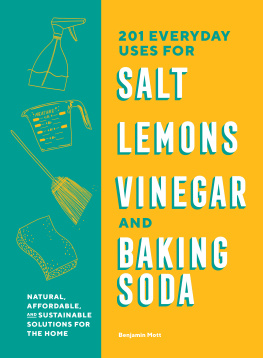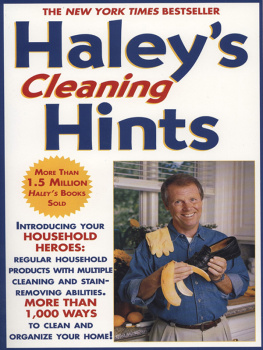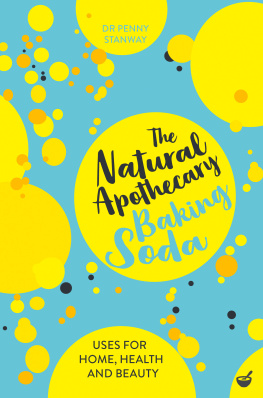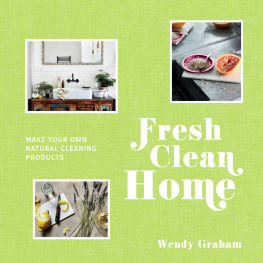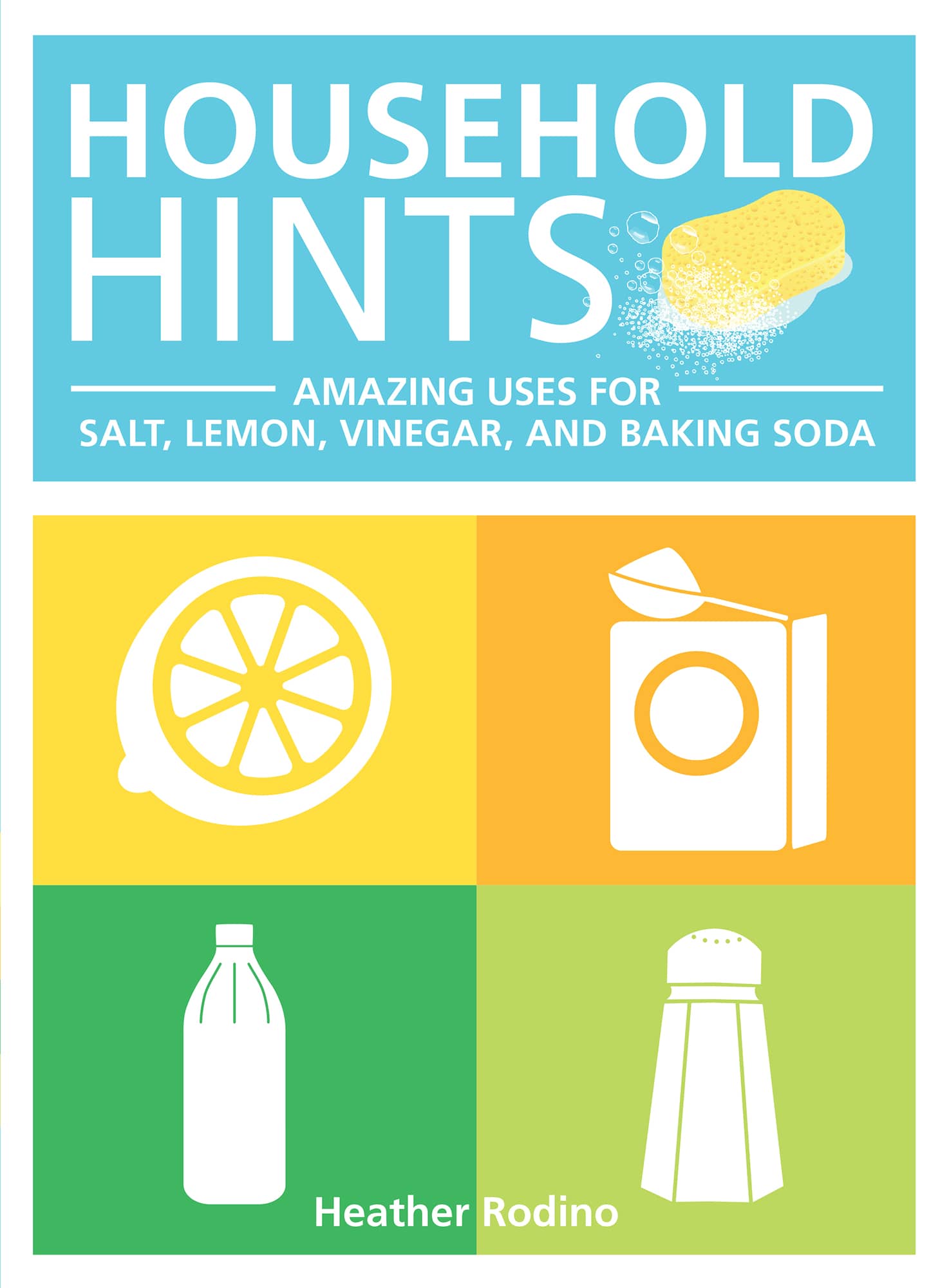HOUSEHOLD HINTS

AMAZING USES FOR
SALT, LEMON, VINEGAR, AND BAKING SODA
Heather Rodino

CONTENTS
Guide
INTRODUCTION
Walk into any big-box discount store, hardware store, or supermarket, and on the shelves youll find specialized cleaning products for almost every imaginable task: stainless steel wipes, granite cleaners, microwave cleaners, electronics cleaners, cleaners that specifically tackle hard-water spots or soap scum, products that remove sticky and gummy residues, cooktop cleaners, and even washing machine cleaners. We can freshen our home with various sprays, candles, and odor eliminators that plug into an electrical outlet or get stuck in the toilet. When it comes to beauty products, the list is just as long, if not longer: Our bathroom cabinets are filled with toners, cleansers, lotions, scrubs, facial masks, blemish treatments, shampoos, conditioners, bath salts, bubble baths, deodorants, and more.

While its convenient to have so many products to choose from, many of us have at least a nagging worry about the safety of these often-expensive items, some of them made with harsh, toxic chemicals that may not be good for our health, our familys health, or the environment as a whole. (After all, many cleaning products warn you to avoid inhaling the fumes, getting the product on skin, or leaving it on food surfaces.) And if youre at all like me, you also may be attracted to the idea of getting rid of some of that clutter and paring down your cleaning or beauty routine with affordable, time-tested, multipurpose products.
When I was first approached about writing Household Hints, I was a curious skeptic regarding the effectiveness of salt, lemons, baking soda, and vinegar in the home. Sure, I had a box of baking soda in the refrigerator and I occasionally added a little bit of it to freshen up a load of laundry. But I wasnt sure if these humble items could do the job of most of the specialized stuff I already had. Even though I consider myself fairly green and eco-minded, I am also a busy professional, so I confess it seemed so much easier to buy products all ready for use, rather than mixing up my own concoctions.

As I started getting deeper into my research I realized there was only one way to find out how well these products workedtry them! Could baking soda really be as effective at exfoliating my face as my fancy department-store scrub? (Yes, maybe even more so.) Could I, once and for all, eliminate the hard-water stains on my long-suffering glass shower door and bathroom tile with a mix of vinegar and dish soap? (Yes.) Would vinegar and baking soda clear my drain as well as the brand-that-shall-not-be-named that I often resorted to in desperation? (Well, almost.)
One of the first tips I tried was a familiar one: to clean the buildup in my electric teakettle with vinegar. I dumped full-strength vinegar into the bottom and came back fifteen minutes later. I could see the buildup was nearly gone, now swirling loosely around the bottom. For good measure, I filled the kettle the rest of the way with water and put it to boil. That helped remove the remaining scale. No need to buy that expensive calcium- and lime-eliminating product anymore.
After many such little successes, I gradually became a convert to the very real efficacy of these everyday products. I suppose my mom had always told me soand some of the tips youll find here are due to herbut I had to become convinced for myself.
So, if you have always wanted to be greener and more frugal around the home and in your personal care, but have never taken the time to do it, keep reading: This is the book for you. If youre already a veteran in this area, theres plenty here for you as well. From the familiar to the surprising, this book collects hundreds of time-tested home tips and well-loved folk wisdom. Youll see just how easy and affordable it is to incorporate salt, lemon, baking soda, and vinegarin often surprising waysinto your routine. Not only will we look at cleaning and personal care, but well also tackle how these fabulous four ingredients can be used to great effect in the kitchen. (They are, after all, foods!) In addition, youll see how they can help keep your pet clean and spiffy-looking, keep pests away, and make sure your garden and yard stay in top shape. As a bonus, well look at other multipurpose products like hydrogen peroxide, rubbing alcohol, coconut oil, castile soap, and more. Youll find general cleaning tips, home remedies, and spotlights on the best cleaning tools.
Good to Know: When mixing together vinegaror lemonand baking soda, go slowly. The acid in vinegar reacts with the alkaline in baking soda, creating a fizzing, bubbling chemical reaction. Remember those baking soda and vinegar volcanoes from your school days?
While salt, lemon, baking soda, and vinegar are fairly gentle, and these tips have been carefully researched, please use caution and common sense, as they may not be appropriate for, or may react differently to, certain surfaces or fabrics. Lemon and vinegar are, after all, mild acids, and salt is abrasive. Check the manufacturers cleaning recommendations, or try the tip on an inconspicuous area before using it on the entire surface. The same is true with anything you put on your skin or in your body. Try a patch test or check with a doctor if you have any concerns.
Now lets look at each of our ingredients in turn to understand a little bit more about them.
SALT
The salt that most of us use on a daily basis is sodium chloride, or NaCl, as you may remember from your high school chemistry class. One of the main sources of salt is, of course, the ocean, where it occurs in abundance, but it can also be found in underground deposits or even on the earths surface in salt flatsthink of the famous Bonneville Salt Flats in Utah, the Badwater Basin in Death Valley, and Salar de Uyuni, the worlds largest salt flat, located in Bolivia.
Salt is essential to human health: It regulates blood pressure and helps muscles and nerves function properly. Saltiness is also one of the basic tastes, along with sweetness, bitterness, sourness, and the more recently added umami. U.S. dietary guidelines recommend that healthy adults should consume no more than 2300 mg of sodium per day. Too much sodium can be a problem, particularly for those with high blood pressure, diabetes, or kidney disease.
Throughout history, salt has been of paramount importance in preserving and seasoning food, particularly meats, in the thousands of years before refrigeration was invented. While we now take it for granted, salt was once an important trading commodity and even used as currency. The word


